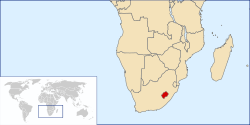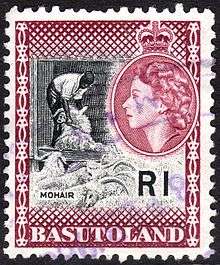Basutoland
| Basutoland[1] | ||||||||||
| British colony | ||||||||||
| ||||||||||
| ||||||||||
| Anthem God Save the Queen | ||||||||||
 | ||||||||||
| Capital | Maseru | |||||||||
| Languages | English (official), Sesotho | |||||||||
| Religion | Christianity, traditional African religion | |||||||||
| Government | Crown Colony | |||||||||
| Resident Commissioner | ||||||||||
| • | 1884–1894 | Marshal James Clarke | ||||||||
| • | 1961–1965 | Alexander Falconer Giles | ||||||||
| History | ||||||||||
| • | 12 March 1868[2](annexed by the UK) | 1884 | ||||||||
| • | Disestablished | 4 October 1966 | ||||||||
| Area | ||||||||||
| • | 1875 | 30,355 km² (11,720 sq mi) | ||||||||
| Population | ||||||||||
| • | 1875 est. | 128,206 | ||||||||
| Density | 4.2 /km² (10.9 /sq mi) | |||||||||
| • | 1904[3] est. | 348,848 | ||||||||
| Density | 11.5 /km² (29.8 /sq mi) | |||||||||
| Currency | Pound sterling | |||||||||
| ||||||||||
Basutoland was a British Crown colony established in 1884 due to the Cape Colony's inability to control the territory. It was divided into seven administrative districts; Berea, Leribe, Maseru, Mohales Hoek, Mafeteng, Qacha's Nek and Quthing.
Basutoland was renamed the Kingdom of Lesotho upon its independence from the United Kingdom on 4 October 1966.
History
Between 1856 and 1868 the Basuto engaged in conflict with the Orange Free State.[1] Their King, Moshoeshoe I, sought British protection.[1] On 29 August 1865, he wrote to Sir Philip Wodehouse, the Governor of Cape Colony:[1]
I am giving myself and my country up to Her Majesty's Government under certain conditions which we may agree on between your Excellency and me.
In July 1866, after referring to the former letter, the Chief said:[1]
All those things I have given up into your hands the last year..., they are still yours. I still continue to be the humble servant of Her Majesty.

Eventually, in January 1868, the Governor received a document dated 9 December 1867, signed by the Secretary of State for the Colonies, authorizing the annexation of Basutoland to Natal (not to the Cape as Wodehouse had wished).[1] On 12 March 1868, a proclamation declared the Basutos to be British subjects and Basutoland to be British territory.[4] It was not in fact annexed to Natal but was placed directly under the authority of the High Commissioner for South Africa. Three years later, it was annexed to the Cape Colony by Act No. 12 of 1871 of the Parliament of the Cape of Good Hope, confirmed by Order in Council of 3 November 1871.[1] Cape Colony rule was not popular with the people and by an Order in Council dated 2 February 1884, and brought into force on 18 March 1884,[5] the royal assent was given to a Cape bill repealing the Act of 1871. Basutoland was brought under the direct authority of the Queen and legislative and executive powers were vested in the High Commissioner.[1]
Executive branch
Basutoland's Executive Council members were the resident commissioner, who presided, three ex-officio members and four council members from the Basutoland National Council, appointed by the resident commissioner, one by the Paramount Chief and three nominated by the Council itself, selected by secret ballot.
Legislative branch
The legislative council, known as the Basutoland National Council, consisted of a non-voting President appointed by the Resident Commissioner, four official members (ex officio), twenty-two Chiefs, forty elected members elected by District Councils, and fourteen nominated members appointed by the Resident Commissioner on the nomination of the Paramount Chief. The Resident Commissioner had the right to address the Council.
The Commissioner had authority to make laws by Proclamation on certain subjects, such as external affairs, defense and the public service. These matters were excluded from the powers of the National Council, but the Commissioner was required to lay a draft of any Proclamation before the Council and to consider their observations. The Constitution made special provision regarding particular objections made by the Council.
Paramount Chief
There was a College of Chiefs of Basutoland whose function related to matters pertaining to the offices of the Paramount Chief, Chief and Headman. Their decisions and recommendations were submitted for acceptance to the Paramount Chief. They were subject to review by the High Court.
The Constitution vested a number of functions in the Paramount Chief. In exercising these, he was required in most cases to consult either with the Executive Concil or with the Resident Commissioner, a Council member of the Executive and a member of the Basuto Nation appointed by himself.
Land in Basutoland was vested by the Constitution in the Paramount Cheief in trust for the Basuto Nation, subject to lawfully acquired rights.
Population
![]() This article incorporates text from a publication now in the public domain: Chisholm, Hugh, ed. (1911). "Basutoland". Encyclopædia Britannica (11th ed.). Cambridge University Press.
Considering the extensive area of uninhabitable mountain land it contained, the territory supported a large population. The inhabitants increased from 128,206 in 1875, to 348,848 in 1904. Women outnumbered men by about 20,000, which was, however, about the number of adult men away from the country at any given period. The majority lived in the district between the Maluti mountains and the Caledon river. The great bulk of the people were Basuto, but there were some thousands of Barolong. The white inhabitants in 1904 numbered 895. The seat of government was Maseru, on the left bank of the Caledon, with a population of about 1000 including some 100 Europeans. There were numerous mission stations throughout Basutoland, to several of which Biblical names have been given, such as Shiloh, Hermon, Cana, Bethesda, and Berea.
This article incorporates text from a publication now in the public domain: Chisholm, Hugh, ed. (1911). "Basutoland". Encyclopædia Britannica (11th ed.). Cambridge University Press.
Considering the extensive area of uninhabitable mountain land it contained, the territory supported a large population. The inhabitants increased from 128,206 in 1875, to 348,848 in 1904. Women outnumbered men by about 20,000, which was, however, about the number of adult men away from the country at any given period. The majority lived in the district between the Maluti mountains and the Caledon river. The great bulk of the people were Basuto, but there were some thousands of Barolong. The white inhabitants in 1904 numbered 895. The seat of government was Maseru, on the left bank of the Caledon, with a population of about 1000 including some 100 Europeans. There were numerous mission stations throughout Basutoland, to several of which Biblical names have been given, such as Shiloh, Hermon, Cana, Bethesda, and Berea.
Districts
- Berea District
- Leribe District
- Maseru District
- Mohales Hoek District
- Mafeteng District
- Qacha's Nek District
- Quthing District
British Resident Commissioners
| Incumbent | Tenure | Notes | |
|---|---|---|---|
| Took office | Left office | ||
| Sir Marshal James Clarke | 18 March 1884 | 18 September 1894 | afterwards Resident Commissioner in Zululand, 1894 |
| Godfrey Yeatsman Lagden | 18 September 1894 | 1895 | |
| Sir Herbert Cecil Sloley | 1895 | ||
| Godfrey Yeatsman Lagden | 1895 | 1901 | |
| Sir Herbert Cecil Sloley | 1902 | 1903 | |
| James MacGregor | 1913 | ||
| Sir Herbert Cecil Sloley | 1913 | 1916 | |
| Robert Thorne Coryndon | 1916 | 1917 | afterwards Governor of Uganda, 1918 |
| Edward Charles Frederick Garraway | 1917 | Apr 1926 | |
| John Christian Ramsay Sturrock | Apr 1926 | Mar 1935 | |
| Sir Edmund Charles Smith Richards | Mar 1935 | Aug 1942 | afterwards Governor of Nyasaland, 1942 |
| Sir Charles Noble Arden-Clarke | Aug 1942 | Nov 1946 | afterwards Governor of Sarawak, 1946 |
| Aubrey Denzil Forsyth-Thompson | Nov 1946 | 24 October 1951 | |
| Edwin Porter Arrowsmith | 24 October 1951 | Sep 1956 | |
| Alan Geoffrey Tunstal Chaplin | Sep 1956 | 1961 | |
| Alexander Falconer Giles | 1961 | 30 April 1965 | |
Chief Justices
The Chief Justice was the Chief Justice of the High Commission Territories (Basutoland, Bechuanaland Protectorate & Swaziland). [6] From 1951 the Chief Justices were:
| Incumbent | Tenure | Notes | |
|---|---|---|---|
| Took office | Left office | ||
| Walter Harragin | 1951 | 1952 | |
| Harold Curwen Willan | 1952 | 1956 | |
| Herbert Charles Fahie Cox | 1957 | ? | |
| Peter Watkin-Williams | 1961 | ? | |
References
- 1 2 3 4 5 6 7 8 Commonwealth and Colonial Law by Kenneth Roberts-Wray, London, Stevens, 1966. P. 777
- ↑ Commonwealth and Colonial Law by Kenneth Roberts-Wray, London, Stevens, 1966. P. 777
- ↑ "Census of the British empire. 1901". Openlibrary.org. 1906. p. 160. Retrieved 26 December 2013.
- ↑ Tylden, The Rise of the Basuto, p 107
- ↑ S.R.O. & S.I. Rev. III, 79
- ↑ "Bechuanaland Colonial Administrators c.1884-c.1965". Retrieved 27 February 2016.
External links
| Wikisource has the text of the 1911 Encyclopædia Britannica article Basutoland. |
Coordinates: 29°31′00″S 27°48′00″E / 29.5167°S 27.8000°E

